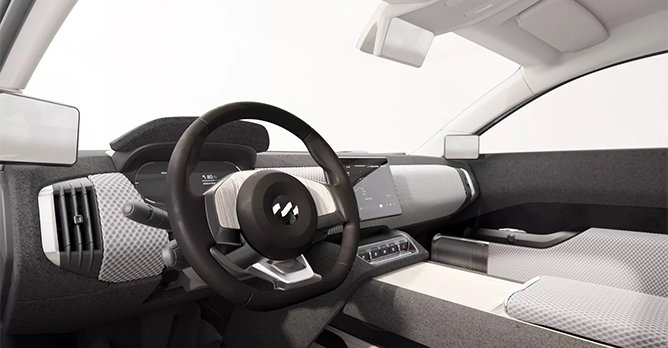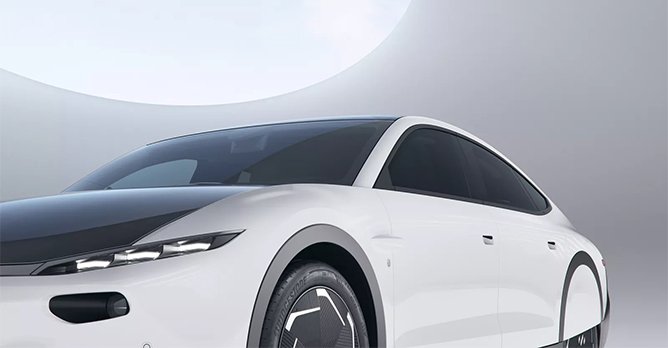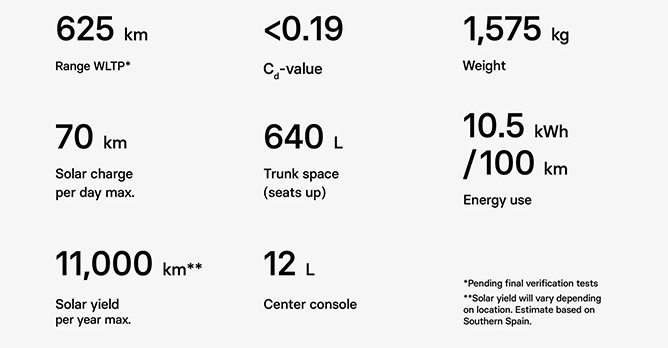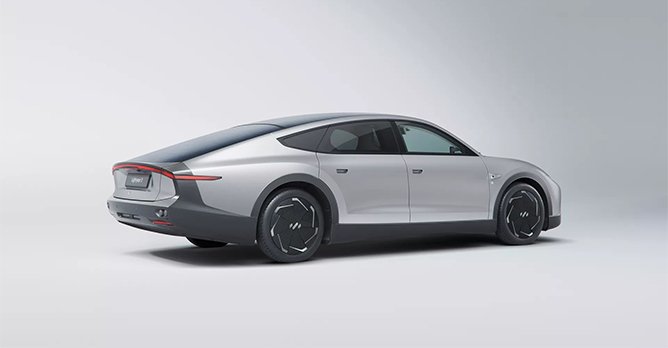The Lightyear 0 is a partially solar-powered production EV with up to 1,000km of range
14 Jun 2022|2,037 views
The first Lightyear will be out in no time - and no, we're not talking about Pixar's latest film.
Rather, Lightyear also happens to be the name of one Netherlands-based startup in the business of electric vehicle building. Except that unlike a large majority of its contemporaries, Lightyear's vehicles are reaching for a specific trick: They also harness energy from the sun for extra range.
Called the 'Lightyear 0', the start-up announced just this week that its first production EV had progressed beyond prototype-phase, and would be officially be open for orders. The first deliveries are estimated to roll out in November.
As a baseline, a 60kWh battery pack will already yield an impressive WLTP-rated 625km of range for the car. But thanks to integrated 5.0m2 solar cells running the full length of the car's body from its bonnet to boot, an extra 70km can apparently be added to its range daily. More ambitious perhaps, is Lightyear's claim of a golden 1,000km of range "between two charging moments".
If this all sounds too good to be true, the caveat, indeed, is that the 70km figure is derived from a 35km workday commute in Southern Spain in spring and summer, while the 1000km figure is based on a 50km workday commute in Amsterdam in summer. Very sunny conditions, over quite long periods of exposure, in other words.
Nonetheless, the thought of having your EV's battery recharged slightly without any plugging in whatsoever is undeniably quite fascinating. More importantly, it points us back to a whole universe of untapped possibilities in the era of cleaner energy.
Solar tech aside, the Lightyear 0 itself isn't something you'd have to buy with your head rather than heart.
In building towards a record-breaking drag coefficient of less than 0.19Cd, the car features a swooping, slippery, and wholly breathtaking shape that brings to mind the Mercedes-Benz Vision EQXX. Slim headlights and a curved bonnet also mean that the Lightyear 0 may bear a passing resemblance to the Lucid Air from the front, but view it from the side and rear, and it stands apart again with its fastback-coupe skewing (rather than sedan-like) silhouette.
As a side note, the solar panels also inadvertently mean that customers will receive the car in 'dual-tone' as standard, which works to its advantage, given its already beautiful shape. Other highlights include all-wheel drive thanks to four in-wheel, independent motors, as well as a completely vegan interior.

 As part of the start-up's show of commitment to the green dream, a fully vegan interior will greet owners of the Lightyear 0 The exciting news should once again be taken with some cautious optimism, considering that even what was considered the flashiest start-up (arguably) of the EV world is now running into supply chain bottlenecks. Meanwhile, legacy carmakers have continued to flex their wealth of experience by getting deliveries off the ground at a quicker pace.
As part of the start-up's show of commitment to the green dream, a fully vegan interior will greet owners of the Lightyear 0 The exciting news should once again be taken with some cautious optimism, considering that even what was considered the flashiest start-up (arguably) of the EV world is now running into supply chain bottlenecks. Meanwhile, legacy carmakers have continued to flex their wealth of experience by getting deliveries off the ground at a quicker pace.
What may work to Lightyear's favour, however, is the 0's limited production run of just 946 units, meaning it won't have to reach for the gargantuan sales figures expected of Rivian or Tesla. On the other hand, it's also quite clear that Lightyear isn't intending for this to be a mass-seller. The car is retailing with a jaw-dropping price tag of €250,000 - approximately S$363,000.
Lightyear says that the '0' will ultimately pave the way for a more accessible, high volume model that it's now calling the '2'. That should come with a far more palatable targeted price point of €30,000 (approximately S$44,000), and a late 2024/early 2025 launch.
Rather, Lightyear also happens to be the name of one Netherlands-based startup in the business of electric vehicle building. Except that unlike a large majority of its contemporaries, Lightyear's vehicles are reaching for a specific trick: They also harness energy from the sun for extra range.
Called the 'Lightyear 0', the start-up announced just this week that its first production EV had progressed beyond prototype-phase, and would be officially be open for orders. The first deliveries are estimated to roll out in November.
As a baseline, a 60kWh battery pack will already yield an impressive WLTP-rated 625km of range for the car. But thanks to integrated 5.0m2 solar cells running the full length of the car's body from its bonnet to boot, an extra 70km can apparently be added to its range daily. More ambitious perhaps, is Lightyear's claim of a golden 1,000km of range "between two charging moments".
If this all sounds too good to be true, the caveat, indeed, is that the 70km figure is derived from a 35km workday commute in Southern Spain in spring and summer, while the 1000km figure is based on a 50km workday commute in Amsterdam in summer. Very sunny conditions, over quite long periods of exposure, in other words.
Nonetheless, the thought of having your EV's battery recharged slightly without any plugging in whatsoever is undeniably quite fascinating. More importantly, it points us back to a whole universe of untapped possibilities in the era of cleaner energy.
Solar tech aside, the Lightyear 0 itself isn't something you'd have to buy with your head rather than heart.
In building towards a record-breaking drag coefficient of less than 0.19Cd, the car features a swooping, slippery, and wholly breathtaking shape that brings to mind the Mercedes-Benz Vision EQXX. Slim headlights and a curved bonnet also mean that the Lightyear 0 may bear a passing resemblance to the Lucid Air from the front, but view it from the side and rear, and it stands apart again with its fastback-coupe skewing (rather than sedan-like) silhouette.
As a side note, the solar panels also inadvertently mean that customers will receive the car in 'dual-tone' as standard, which works to its advantage, given its already beautiful shape. Other highlights include all-wheel drive thanks to four in-wheel, independent motors, as well as a completely vegan interior.

What may work to Lightyear's favour, however, is the 0's limited production run of just 946 units, meaning it won't have to reach for the gargantuan sales figures expected of Rivian or Tesla. On the other hand, it's also quite clear that Lightyear isn't intending for this to be a mass-seller. The car is retailing with a jaw-dropping price tag of €250,000 - approximately S$363,000.
Lightyear says that the '0' will ultimately pave the way for a more accessible, high volume model that it's now calling the '2'. That should come with a far more palatable targeted price point of €30,000 (approximately S$44,000), and a late 2024/early 2025 launch.
The first Lightyear will be out in no time - and no, we're not talking about Pixar's latest film.
Rather, Lightyear also happens to be the name of one Netherlands-based startup in the business of electric vehicle building. Except that unlike a large majority of its contemporaries, Lightyear's vehicles are reaching for a specific trick: They also harness energy from the sun for extra range.
Called the 'Lightyear 0', the start-up announced just this week that its first production EV had progressed beyond prototype-phase, and would be officially be open for orders. The first deliveries are estimated to roll out in November.
As a baseline, a 60kWh battery pack will already yield an impressive WLTP-rated 625km of range for the car. But thanks to integrated 5.0m2 solar cells running the full length of the car's body from its bonnet to boot, an extra 70km can apparently be added to its range daily. More ambitious perhaps, is Lightyear's claim of a golden 1,000km of range "between two charging moments".
If this all sounds too good to be true, the caveat, indeed, is that the 70km figure is derived from a 35km workday commute in Southern Spain in spring and summer, while the 1000km figure is based on a 50km workday commute in Amsterdam in summer. Very sunny conditions, over quite long periods of exposure, in other words.
Nonetheless, the thought of having your EV's battery recharged slightly without any plugging in whatsoever is undeniably quite fascinating. More importantly, it points us back to a whole universe of untapped possibilities in the era of cleaner energy.
Solar tech aside, the Lightyear 0 itself isn't something you'd have to buy with your head rather than heart.
In building towards a record-breaking drag coefficient of less than 0.19Cd, the car features a swooping, slippery, and wholly breathtaking shape that brings to mind the Mercedes-Benz Vision EQXX. Slim headlights and a curved bonnet also mean that the Lightyear 0 may bear a passing resemblance to the Lucid Air from the front, but view it from the side and rear, and it stands apart again with its fastback-coupe skewing (rather than sedan-like) silhouette.
As a side note, the solar panels also inadvertently mean that customers will receive the car in 'dual-tone' as standard, which works to its advantage, given its already beautiful shape. Other highlights include all-wheel drive thanks to four in-wheel, independent motors, as well as a completely vegan interior.

 As part of the start-up's show of commitment to the green dream, a fully vegan interior will greet owners of the Lightyear 0 The exciting news should once again be taken with some cautious optimism, considering that even what was considered the flashiest start-up (arguably) of the EV world is now running into supply chain bottlenecks. Meanwhile, legacy carmakers have continued to flex their wealth of experience by getting deliveries off the ground at a quicker pace.
As part of the start-up's show of commitment to the green dream, a fully vegan interior will greet owners of the Lightyear 0 The exciting news should once again be taken with some cautious optimism, considering that even what was considered the flashiest start-up (arguably) of the EV world is now running into supply chain bottlenecks. Meanwhile, legacy carmakers have continued to flex their wealth of experience by getting deliveries off the ground at a quicker pace.
What may work to Lightyear's favour, however, is the 0's limited production run of just 946 units, meaning it won't have to reach for the gargantuan sales figures expected of Rivian or Tesla. On the other hand, it's also quite clear that Lightyear isn't intending for this to be a mass-seller. The car is retailing with a jaw-dropping price tag of €250,000 - approximately S$363,000.
Lightyear says that the '0' will ultimately pave the way for a more accessible, high volume model that it's now calling the '2'. That should come with a far more palatable targeted price point of €30,000 (approximately S$44,000), and a late 2024/early 2025 launch.
Rather, Lightyear also happens to be the name of one Netherlands-based startup in the business of electric vehicle building. Except that unlike a large majority of its contemporaries, Lightyear's vehicles are reaching for a specific trick: They also harness energy from the sun for extra range.
Called the 'Lightyear 0', the start-up announced just this week that its first production EV had progressed beyond prototype-phase, and would be officially be open for orders. The first deliveries are estimated to roll out in November.
As a baseline, a 60kWh battery pack will already yield an impressive WLTP-rated 625km of range for the car. But thanks to integrated 5.0m2 solar cells running the full length of the car's body from its bonnet to boot, an extra 70km can apparently be added to its range daily. More ambitious perhaps, is Lightyear's claim of a golden 1,000km of range "between two charging moments".
If this all sounds too good to be true, the caveat, indeed, is that the 70km figure is derived from a 35km workday commute in Southern Spain in spring and summer, while the 1000km figure is based on a 50km workday commute in Amsterdam in summer. Very sunny conditions, over quite long periods of exposure, in other words.
Nonetheless, the thought of having your EV's battery recharged slightly without any plugging in whatsoever is undeniably quite fascinating. More importantly, it points us back to a whole universe of untapped possibilities in the era of cleaner energy.
Solar tech aside, the Lightyear 0 itself isn't something you'd have to buy with your head rather than heart.
In building towards a record-breaking drag coefficient of less than 0.19Cd, the car features a swooping, slippery, and wholly breathtaking shape that brings to mind the Mercedes-Benz Vision EQXX. Slim headlights and a curved bonnet also mean that the Lightyear 0 may bear a passing resemblance to the Lucid Air from the front, but view it from the side and rear, and it stands apart again with its fastback-coupe skewing (rather than sedan-like) silhouette.
As a side note, the solar panels also inadvertently mean that customers will receive the car in 'dual-tone' as standard, which works to its advantage, given its already beautiful shape. Other highlights include all-wheel drive thanks to four in-wheel, independent motors, as well as a completely vegan interior.

What may work to Lightyear's favour, however, is the 0's limited production run of just 946 units, meaning it won't have to reach for the gargantuan sales figures expected of Rivian or Tesla. On the other hand, it's also quite clear that Lightyear isn't intending for this to be a mass-seller. The car is retailing with a jaw-dropping price tag of €250,000 - approximately S$363,000.
Lightyear says that the '0' will ultimately pave the way for a more accessible, high volume model that it's now calling the '2'. That should come with a far more palatable targeted price point of €30,000 (approximately S$44,000), and a late 2024/early 2025 launch.
Latest COE Prices
August 2025 | 1st BIDDING
NEXT TENDER: 20 Aug 2025
CAT A$102,009
CAT B$123,498
CAT C$70,001
CAT E$122,334
View Full Results Thank You For Your Subscription.

























